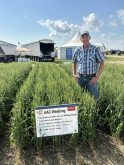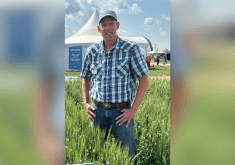Growers are leaving profit on the ground every time the combine hits the field.
“You’ve grown it, you’ve put the inputs into it, and it’s free for the taking. Why not take it?” said Nathan Gregg, project manager at the Prairie Agricultural Machinery Institute.
Harvest losses depend on the crop, but typically, one to two bushels per acre is considered an “acceptable” loss, said Gregg.
“Unfortunately, in a lot of cases, we see up to five to 10 bushels an acre of losses,” he said. “I’ve been in fields where we’ve seen losses of 15 bushels per acre in a canola crop that the producer thought he was doing a good job with.”
Read Also

U.S. wheat growers worried about industry moving north
U.S. wheat producers are concerned that American wheat production may begin to migrate north of the border.
Losses can be caused by many factors, but they start with a “lack of awareness,” said Gregg.
“Not checking to see if losses are there is the main culprit on a lot of operations,” he said. “I think we’re getting a little bit better. The message is getting through, and producers are starting to check, and that’s somewhat related to the price of commodity grains.
“As people are checking more, they’re doing a better job of limiting those losses.”
That can be tough to do during the busy harvest season, though.
“It’s a busy season and there’s lots to get done,” he said. “The goal on everyone’s mind is to get that crop off before something happens to it, so stopping to check is not really high on the agenda when there’s a nagging concern to get the job done.
“But checking in any format is better than not checking at all.”
The best way to check is to remove the chopper from the combine and drop residue material in a windrow behind the machine, using a catch pan to collect the residue in order to measure losses.
“But a lower-effort methodology is to try and catch the residue as it’s discharged off the straw chopper or residue spreader. That’s not terrible — it’s just not as good,” said Gregg.
“It introduces opportunities for error. The loss that comes out of the combine may not be distributed evenly, so if you’re just catching a pan on the periphery of the discharge pattern, that may not be where the grain is discharged, even though that’s where some of the straw and residue is.”
Once the discharge is caught, you can remove the residue, either by hand or using a small leaf blower, to get a seed count.
“Collect the loss, and in some format, try to apply a metric to that, whether that’s seed counting on larger kernels or by weight or by volume — anything that gives you context to know whether the adjustments that you’re making in speed or combine settings are resulting in more or less loss.”
Harvest loss triggers
Once you’re aware of how much seed you’re leaving in the field, you’ve won half the battle, said Gregg.
“The fact that you’re even considering it will make it so that you’re paying attention when those environmental conditions change throughout the day,” he said, adding wind or temperature can affect how the crop flows through the combine.
“If you’re paying attention, maybe you’ll start to realize some of those triggers and realize you need to adjust some of your settings or your travel speed to adapt to the crop conditions.”
Losses can happen in many places — “from environmental shattering losses to losses at the header and the cutter bar and throughout the combine process itself. There’s different opportunities for grain to be lost and not retained in the combine.”
But one of the primary causes is human nature — giving into the desire to get the job done faster.
“There’s always settings and optimizations that can be made to try to address the crop conditions and cater the machine to that,” said Gregg. “Typically, speed is the thing that tends to get neglected. We think that we can drive at a certain speed in all conditions at all yield levels.”
New combines have so much horsepower that they don’t always give you a “visceral response to tell that something isn’t going quite right.”
“You don’t feel the rumble in your seat or hear the engine pull down like it used to in heavy conditions.”
Producers also need to realize “it’s not one setting for one crop all season,” he added.
“We need to be in tune with what’s going on with the environment,” said Gregg.
“First-harvest wheat will behave differently in the combine than last-harvested wheat. We need to be aware of how that can change over the course of a season and even over the course of the day.”















